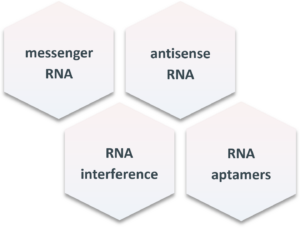The Impact of RNA-based medicines on healthcare
Recent breakthroughs in Ribonucleic Acid (RNA)-based drug design and, more recently, the use of mRNA vaccines against COVID-19 have inspired a revival of interest in the therapeutic potential of RNA. The last ten years have seen a considerable increase in RNA-based research, clinical development, and commercial activity. During this time, there have been monumental developments in technology and strategies to generate novel therapeutics, resulting in the approval of several RNA-based medicines. This blog discusses RNA-based therapy, its impact on healthcare and its potential to be an effective, well-tolerated, targeted therapy for a broad range of disease areas, including previously incurable conditions.
Background
To date, only 0.05% of the human genome has been drugged or targeted by protein-targeted therapeutics (small molecules and antibodies), and most disease targets lack a defining active site for small-molecule binding.1 Targeted RNA therapy represents the biggest potential in drug development, enabling the treatment of a myriad of previously incurable or un-druggable diseases.
There are four main types of RNA-based medicines: messenger RNA (mRNA), antisense RNA (asRNA), RNA interference (RNAi), and RNA aptamers1,2. Each has advantages and challenges, at different stages of development and clinical use.
mRNA
mRNA medicines deliver synthetic mRNA molecules that code for a desired protein, such as an enzyme, a hormone, or an antigen. The mRNA is taken up by the cells and translated into the protein, which can then perform its function or trigger an immune response. mRNA technology has enjoyed heightened attention in recent years after being successfully used to develop vaccines against COVID-19, notably the Pfizer-BioNTech and Moderna vaccines. These vaccines have shown high efficacy and safety and have been widely distributed worldwide. In addition to COVID-19, mRNA vaccines are also being developed for many other viruses, including influenza, CMV, RSV, and Zika.
mRNA medicines can also be used to treat diseases caused by a lack of protein or defective protein, such as cystic fibrosis, by the delivery of mRNA encoding for a functional cystic fibrosis transmembrane conductance regulator (CFTR) protein to patients with CFTR mutations. There are many mRNA therapies in development, with the majority focusing on either infectious diseases or oncology, where a large number are co-administered with cytokine cocktails or checkpoint modulators for the treatment of solid-organ tumors.
However, mRNA medicines face challenges, including stability, delivery, safety, and scalability issues. mRNA molecules are prone to degradation by enzymes and need to be protected by lipid nanoparticles or other carriers for delivery. They may also trigger immune reactions or inflammatory responses, impacting efficacy and tolerability. Moreover, mRNA medicines require complex manufacturing processes and cold-chain storage, which may limit their availability and affordability.
asRNA
asRNA medicines use synthetic RNA molecules that are complementary to a target mRNA and bind to it, preventing it from being translated into protein. Short single-stranded oligonucleotides are classed as either occupancy-mediated degradation or occupancy-only types and are used to reduce the expression of genes that are overactive or harmful, such as oncogenes or viral genes, and can restore or modify protein expression.
asRNA medicines have been approved for some rare diseases, such as hereditary transthyretin-mediated amyloidosis and spinal muscular atrophy. Spinal muscular atrophy is a disease caused by mutations in the survival motor neuron (SMN) 1 gene, leading to the loss of motor neurons and muscle weakness. The FDA approved an asRNA medicine called nusinersen (Spinraza) in 2016. This targets the SMN2 mRNA and increases its splicing efficiency, thereby increasing the production of functional SMN protein.
There have been several such notable successes with asRNA medicines. However, asRNA medicines also face challenges, including specificity, stability, delivery (nusinersen requires intrathecal injection), elimination (long half-life in the CNS), safety, and resistance. asRNA molecules must be designed carefully to avoid off-target effects or cross-reactivity with other RNAs. asRNA medicines also need efficient delivery systems to reach their target tissues or cells effectively, and they may induce resistance mechanisms such as RNA editing or mutation, which may reduce their efficacy over time.
RNAi
RNAi medicines use small interfering RNA (siRNA), short double-stranded RNAs, or micro RNA (miRNA). These single-stranded non-coding RNA molecules can be harnessed as either miRNA replacement therapy using miRNA mimics (miRNA that behaves similarly to endogenous miRNAs) or inhibition of miRNA function by antimiRs (also known as miRNA inhibitors). RNAi-based therapeutics can also reduce the expression of overactive or harmful genes by degrading the target mRNA or inhibiting its translation. miRNA and antimiR medicines are currently in early clinical development, while siRNA medicines have been approved for some rare diseases, such as Primary hyperoxaluria and transthyretin amyloidosis.
There are numerous siRNA medicines in late-stage development, but the first double-stranded siRNA medicine approved by the FDA was patisiran (ONPATTRO) in 2018. Patisiran was approved for the treatment of polyneuropathy of hereditary transthyretin-mediated amyloidosis. It targets the TTR mRNA and induces degradation, reducing TTR protein and protein deposits.
RNAi medicines also face issues around delivery, safety, and resistance. As with other RNA therapeutic subtypes, RNAi molecules need efficient delivery systems to reach their target tissues or cells, such as lipid nanoparticles or conjugates. Moreover, like asRNA therapeutics, RNAi medicines may also induce resistance mechanisms such as RNA editing or mutation, which may reduce their efficacy over time.
RNA aptamers
RNA aptamers are short, single-stranded oligonucleotides that are selected to bind to a specific target molecule with high affinity and specificity. This can affect the activity of the target molecule, such as a protein or a cell surface receptor. RNA aptamers may act as agonists or antagonists of the target molecule, modulating its function or downstream signaling. Antagonistic RNA aptamers have been developed for diseases such as wet age-related macular degeneration.
Wet age-related macular degeneration is a disease caused by angiogenesis (the abnormal growth of blood vessels) in the retina, which leads to vision loss. An RNA aptamer called pegaptanib (Macugen) was approved by the FDA in 2004, binds to vascular endothelial growth factor (VEGF) and inhibits binding to its receptor. VEGF induces angiogenesis and increases vascular permeability and inflammation; therefore, VEGF antagonism by pegaptanib reduces the growth of blood vessels in the retina. There are numerous other aptamers in clinical development for a wide range of therapeutic areas.
Some of the challenges faced by RNA aptamers include stability, delivery, safety, and immunogenicity. RNA aptamers are also prone to degradation by enzymes in the body and need to be modified or protected for stability. RNA aptamers also need efficient delivery systems to reach their target tissues or cells and may induce immune responses or neutralizing antibodies, which may reduce their efficacy or cause allergic reactions.
Recent developments
Interest in RNA medicines has increased exponentially over recent years. In 1999, 7,000 articles were published on RNA medicines and 3,000 patents, but by 2019, this had risen to 40,000 papers and 12,000 patents2. There are now more than 450 RNA medicines approved or in development, representing 14% of all programs in development, surpassed only by infectious diseases and oncology. Fifty percent of all RNA medicine programs are in pre-clinical development, 23% are in Phase 1, 16% in Phase 2, 7% in Phase 3 and 4% are marketed, demonstrating the ongoing interest of the pharmaceutical industry in future RNA medicines3. This interest and investment has resulted in a staggering progression for RNA medicines in terms of safety, tolerability, efficacy and specificity. RNA medicines undoubtedly have their challenges, but each challenge is a new opportunity for development, and in recent years, significant progress has been made in addressing the problems inherent in this drug class.
For example, RNA molecules are relatively unstable compared to many other biomolecules, and when introduced to the body, foreign RNA often triggers an immune response, impacting the efficacy and tolerability of RNA medicines. In addition, RNA molecules need safe and efficient delivery into the cytoplasm to avoid degradation and engage their target. There have been significant breakthroughs in overcoming these challenges in recent years, optimizing RNA molecules for diagnostic and therapeutic use. Chemical modifications to asRNAs and siRNAs can improve delivery and resilience as well as reduce toxicity and immunogenicity, and chemical modifications to mRNAs can increase translational ability and reduce immunogenicity. Chemical modifications to CRISPR systems reduce immunogenicity and off-target effects, while modifications to aptamers can significantly improve binding affinity. Developments in targeted delivery systems, including N-acetylgalactosamine (GalNAc) lipid nanoparticles, cationic polymer-based polyplexes, exosomes, spherical nucleic acids (SNAs), and DNA-based nanostructures can also significantly improve the efficiency of intracellular RNA delivery.1,4
Target engagement and specificity issues are also important issues to address in RNA medicines. However, the development of techniques such as CRISPR has revolutionized gene editing. Clustered Regularly Interspaced Short Palindromic Repeats (CRISPR) is based on a simplified version of the bacterial CRISPR-Cas9 system, which consists of two main components: a guide RNA (gRNA) that directs the Cas9 enzyme to a specific 20-nucleotide target sequence in the genome, and the Cas9 enzyme that cuts the double-stranded DNA or single-stranded RNA at that location for genome editing. By introducing a gRNA and Cas9 into a cell, researchers can create precise changes in the DNA, such as deleting, inserting or replacing genes. It also has the potential to address some of the ethical and social issues that have been raised by other forms of genetic engineering, such as transgenic organisms and human germline editing1,5,6.
Developments such as circular RNAs (circRNAs) unlock new potential in efficacy, safety, and tolerability. circRNAs (a subgroup of non-coding RNA) are more stable and resilient than linear RNAs. They can function as antagonistic miRNA sponges to inhibit mRNA function more efficiently than miRNA and have been shown in animal models to stimulate a more potent and long-lasting immune response when used as a COVID-19 vaccine.
Advances in RNA technology mean that RNA medicines are likely to remain centre-stage in drug development for rare, incurable, undruggable, and high unmet diseases for the foreseeable future.1
Clinical development and regulatory considerations
Developing RNA medicines has traditionally been very difficult. However, precedent now exists, and previous approvals can help generate a roadmap for future clinical development plans. Adnovate Clinical’s team of experts in RNA medicine development can help navigate the ever-changing regulatory landscape and identify any routes for niche regulatory positioning (Orphan Drug Designation, accelerated review, etc.).
Challenges continue to exist, and there is no standard regulatory path. Instead, an individualized approach is taken by regulatory authorities based on the specific features of the compound and the indication. This was highlighted by the approval of two RNA medicines for the treatment of polyneuropathy of hereditary transthyretin-mediated amyloidosis. As previously discussed, FDA approved mRNAi patisiran (ONPATTRO) in 2018. During the same year, an asRNA medicine called inotersen (TEGSEDI) was also approved for the same indication. Both were approved following relatively small pivotal trials (active cohort <150 patients that lasted for more than 12 months. They both used the modified Neuropathy Impairment Score +7 (mNIS+7) as the primary endpoint (although TEGSEDI also used the Norfolk Quality of Life Diabetic Neuropathy (QoL-DN) total score as a co-primary). ONPATTRO outperformed TEGSEDI with a mNIS+7 LS mean treatment difference of -34.0 (95% CI -39.9 to -28.1) vs. -19.7 (95% CI -26.4 to -13.0), respectively. There is a significant difference in delivery with ONPATTRO requiring IV administration following a relatively inconvenient pre-medication with IV corticosteroids, oral acetaminophen and IV H1 and IV H2 blockers to reduce the risk of infusion-related reactions. TEGSEDI, on the other hand, is given by subcutaneous injection, a delivery method fraught with difficulties such as injection site reactions in as many as 50% of patients. While ONPATTRO received a relatively uncomplicated authorization, TEGSEDI was placed on a REMS program with a black-boxed warning due to thrombocytopenia and glomerulonephritis. Additionally, anti-drug antibody (ADA) rates were considerably higher in patients treated with TEGSEDI (30%) vs ONPATTRO (3.6%).
These two medicines, approved in the same year for the same indication, met considerably different development and regulatory hurdles. Additionally, there are key regulatory considerations absent from current guidance that may be difficult to ascertain from studying the development of previous products, such as differences in requirements for PK studies and QT studies when developing RNA medicines, as well as the lack of clear guidelines for all the aspects of CMC. These chemical entities are bigger than typical small molecules, produced by chemical syntheses, a predictable but impure process, and, like biologics, are difficult to fully characterize because of their molecular composition and heterogeneity. This highlights the lack of a standardized regulatory pathway for RNA medicines and the importance of early input from experts to maximize the chances of clearing the somewhat unclear regulatory hurdles. Adnovate Clinical’s regulatory and clinical development experts can help navigate the changing regulatory landscape and provide clear visualization to address future unmet needs and ensure commercial success.
Future Implications
It is little surprise that RNA medicines development is occupying 14% of the drug development programs worldwide given their potential to revolutionize disease management. RNA medicines are target-specific, predictable in terms of pharmacokinetics and pharmacodynamics, economical compared to antibodies or protein drugs, relatively safe and they are adaptable, given their modular design with easy-to-switch sequences. The boom in RNA medicine development is likely to continue for the foreseeable future, with greater access to sequencing data from tumor biopsies, combined with big data, AI adoption and improved bioinformatic approaches enabling faster and more accurate target identification and RNA therapeutic drug design than was previously possible7. This will also enable small drug developers to utilize their RNA technology in the development of multiple assets, and with regulatory expectations being clarified with every new drug approval, RNA medicine development can be streamlined and de-risked now more than ever before
RNA medicines also represent a huge commercial opportunity to treat previously incurable diseases and conditions with a high residual unmet need. This is evidenced by big pharma looking to RNA medicines for future wins, several approved RNA medicines reaching blockbuster status, and public equity financings having generated over $16B in funding over the past six years. While it is no secret that investment in biotech has fallen since the COVID-19 boom, the RNA market remains strong and generates more than $6B of investment every year3.
RNA medicines target the very basis of diseases, and the development of knowledge and technology in this area allows drug developers to target rare and previously incurable diseases with huge potential for clinical impact and commercial success. Here at Adnovate, we have a team of global experts in rare diseases and genetic medicines who have a strong history of RNA medicine development and subsequent approvals. Adnovate can support the design and development of RNA medicines clinical development programs across all phases to meet regulatory requirements and increase your chances of commercial success.
For more information, please contact us at: https://www.adnovateclinical.com/contact-us/
References
- Zhu, Y., Zhu, L., Wang, X. et al. RNA-based therapeutics: an overview and prospectus. Cell Death Dis. 2022; 13: 644.
- Sasso JM, Ambrose BJB, Tenchov R, Datta RS, Basel MT, DeLong RK, et al. The Progress and Promise of RNA Medicine ─ An Arsenal of Targeted Treatments. J Med Chem. 2022 May 26;65(10):6975–7015.
- Trials & Triumphs of RNA Therapies: TD Cowen RNA technology Landscape Analysis. Cowen and Company, LLC; 2023.
- Niazi SK. RNA Therapeutics: A Healthcare Paradigm Shift. Biomedicines. 2023 Apr 25;11(5):1275.
- Wang JY, Doudna JA. CRISPR technology: A decade of genome editing is only the beginning. Science. 2023 Jan 20;379(6629):eadd8643.
- Madigan V, Zhang F, Dahlman JE. Drug delivery systems for CRISPR-based genome editors. Nat Rev Drug Discov. 2023 Nov;22(11):875–94.
- Vaidya M. Mapping the RNA therapeutics R&D landscape in 2022 [Internet]. Pharmaceutical Technology. 2021 [cited 2024 May 3]. Available from: https://www.pharmaceutical-technology.com/features/mapping-the-rna-therapeutics-rd-landscape-in-2022/
;)


